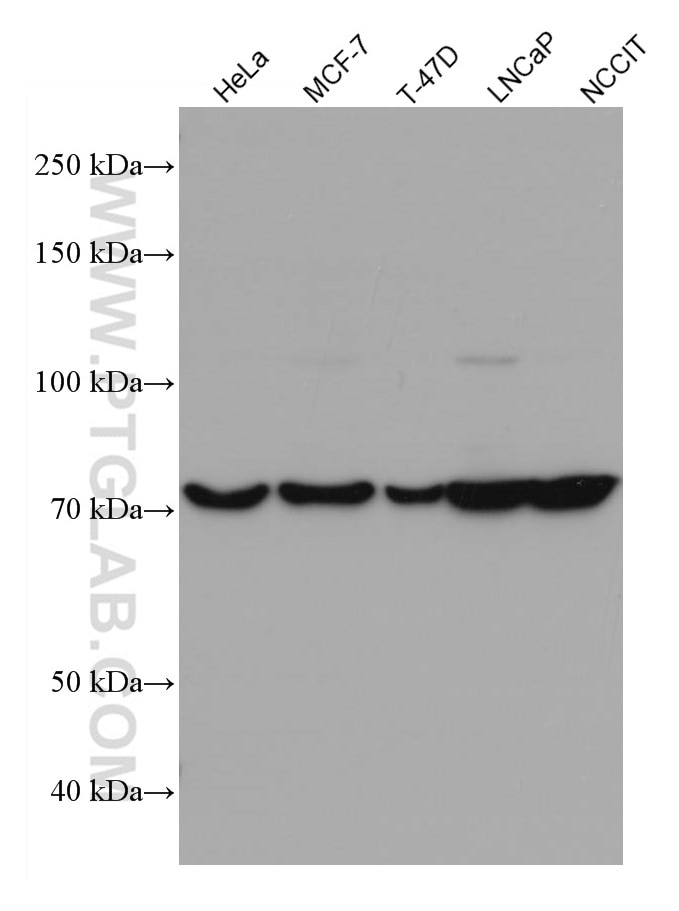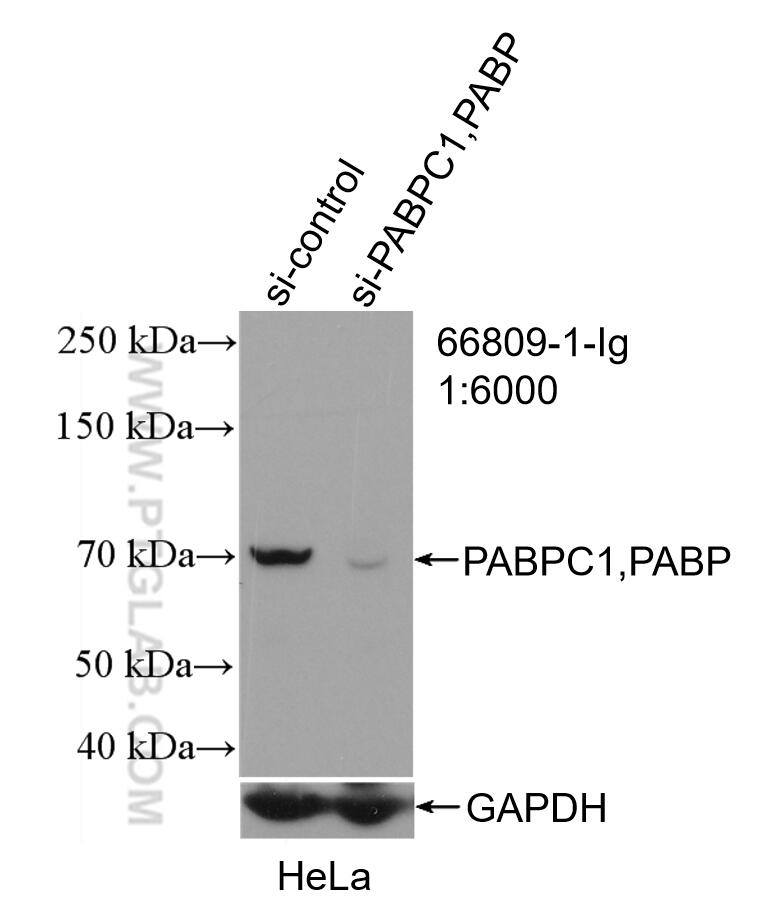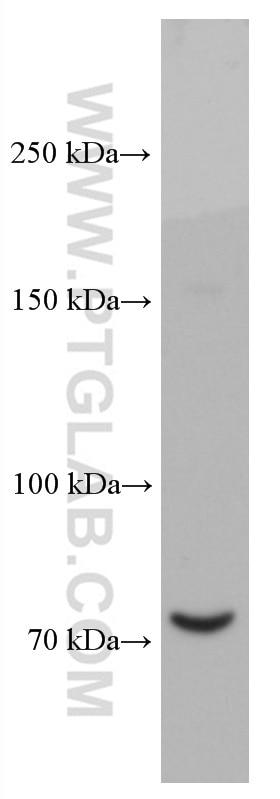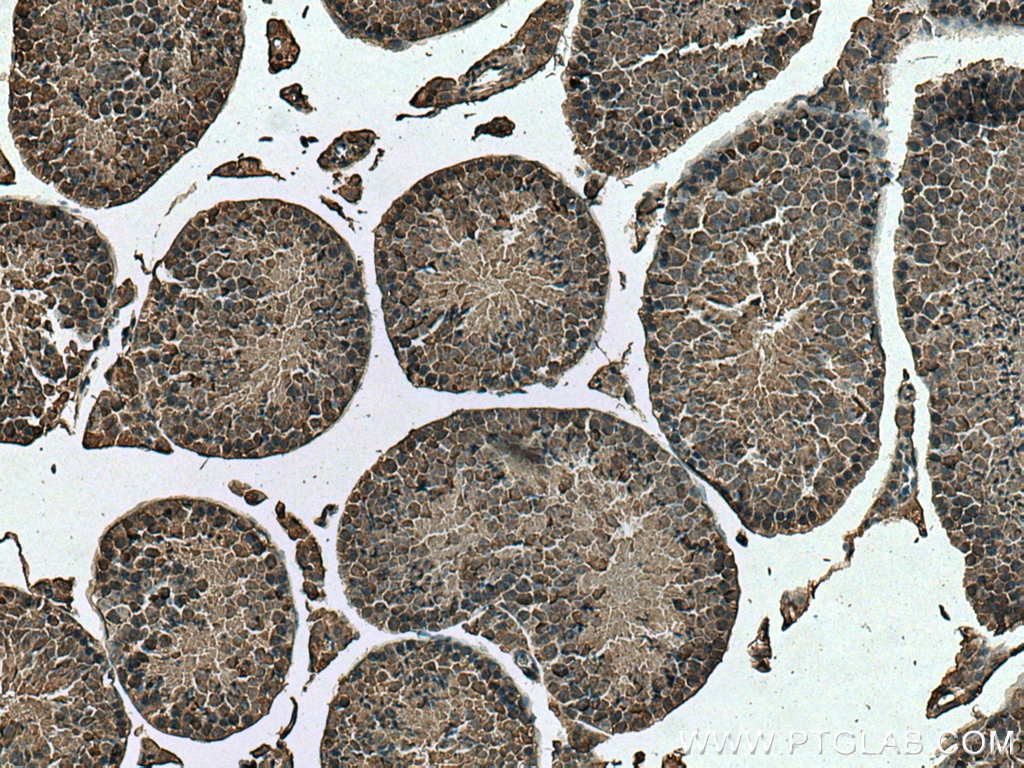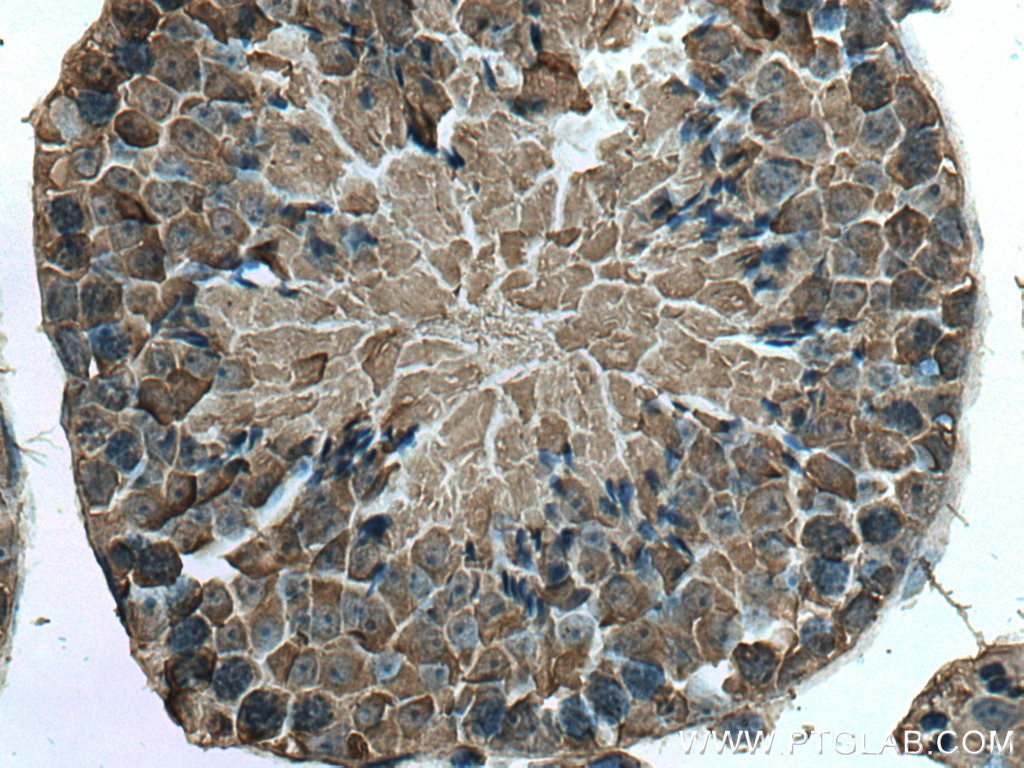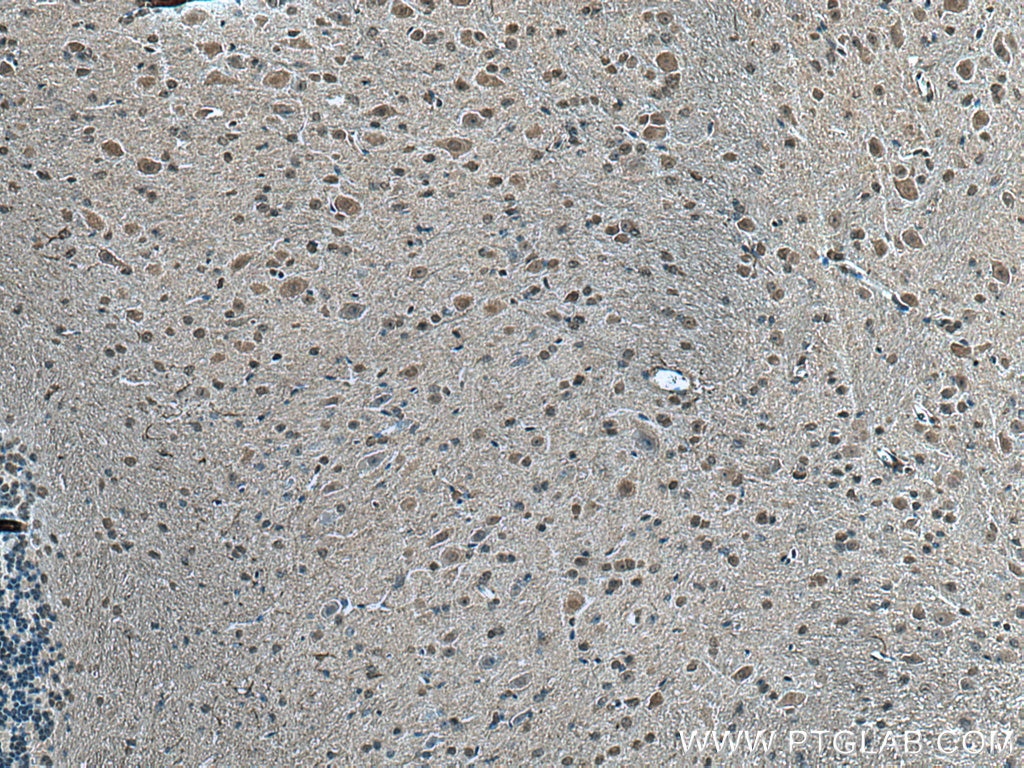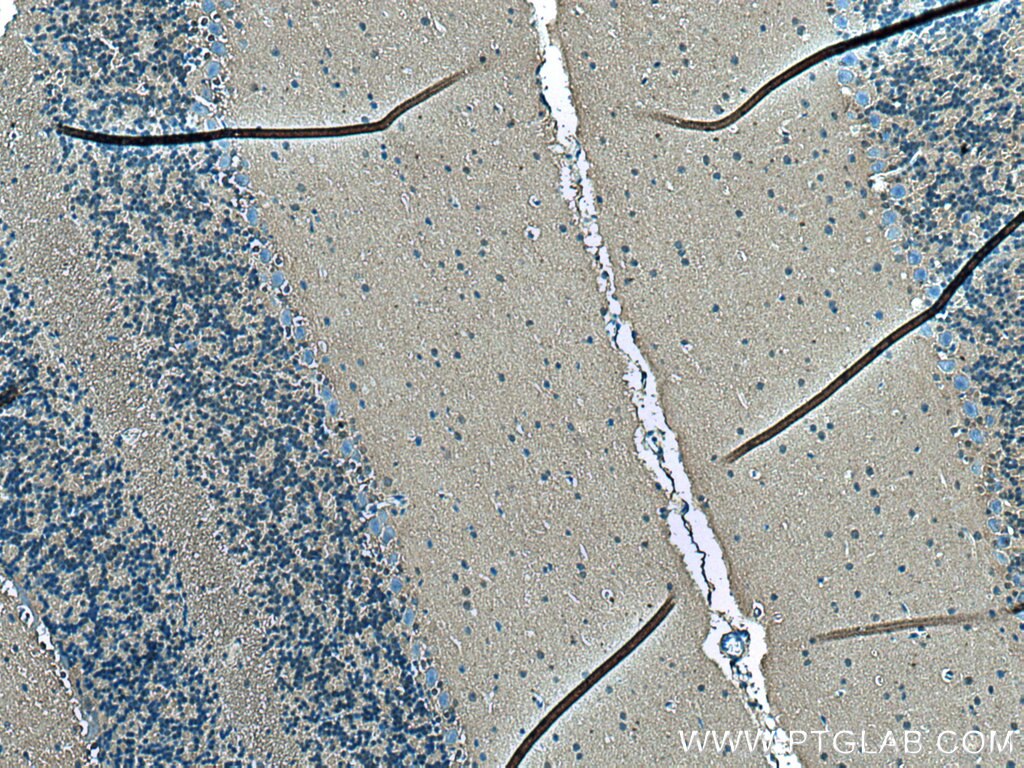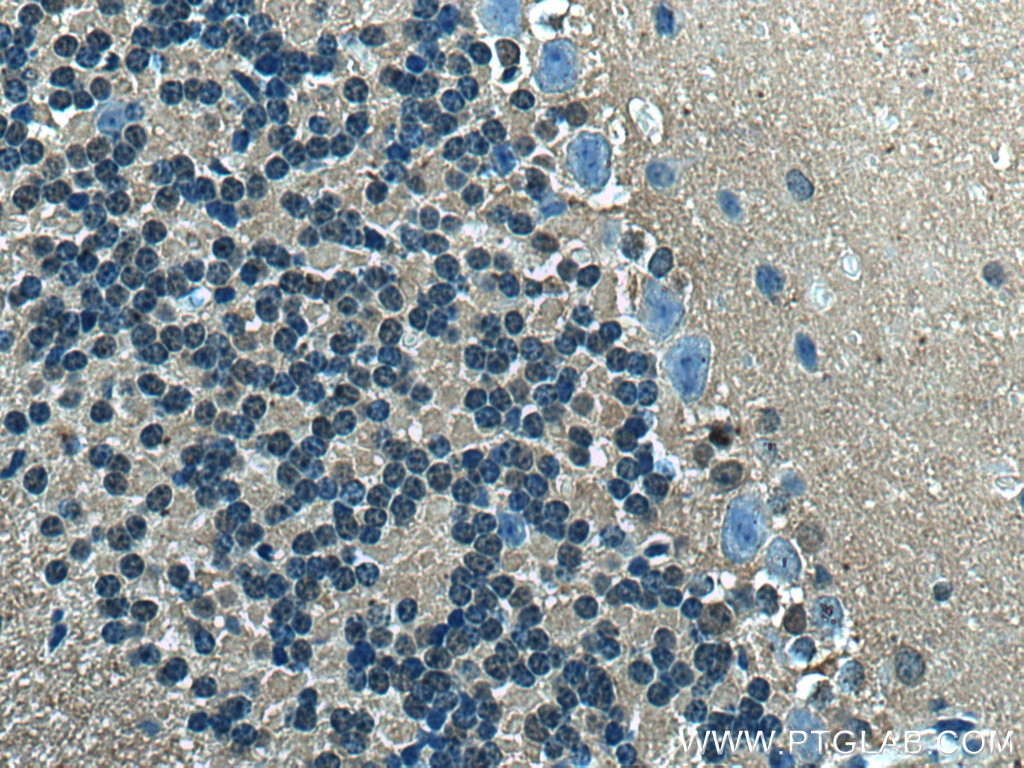- Featured Product
- KD/KO Validated
PABPC1,PABP Monoklonaler Antikörper
PABPC1,PABP Monoklonal Antikörper für WB, IHC, IF/ICC, ELISA
Wirt / Isotyp
Maus / IgG1
Getestete Reaktivität
human, Maus, Ratte und mehr (1)
Anwendung
WB, IHC, IF/ICC, IP, CoIP, ELISA
Konjugation
Unkonjugiert
CloneNo.
3D8B5
Kat-Nr. : 66809-1-Ig
Synonyme
Geprüfte Anwendungen
| Erfolgreiche Detektion in WB | HeLa-Zellen, LNCaP-Zellen, MCF-7-Zellen, NCCIT-Zellen, T-47D-Zellen |
| Erfolgreiche Detektion in IHC | Maushodengewebe, Maus-Cerebellum-Gewebe Hinweis: Antigendemaskierung mit TE-Puffer pH 9,0 empfohlen. (*) Wahlweise kann die Antigendemaskierung auch mit Citratpuffer pH 6,0 erfolgen. |
| Erfolgreiche Detektion in IF/ICC | HEK-293-Zellen |
Empfohlene Verdünnung
| Anwendung | Verdünnung |
|---|---|
| Western Blot (WB) | WB : 1:2000-1:10000 |
| Immunhistochemie (IHC) | IHC : 1:50-1:500 |
| Immunfluoreszenz (IF)/ICC | IF/ICC : 1:50-1:500 |
| It is recommended that this reagent should be titrated in each testing system to obtain optimal results. | |
| Sample-dependent, check data in validation data gallery | |
Veröffentlichte Anwendungen
| KD/KO | See 1 publications below |
| WB | See 3 publications below |
| IHC | See 2 publications below |
| IF | See 3 publications below |
| IP | See 1 publications below |
| CoIP | See 1 publications below |
Produktinformation
66809-1-Ig bindet in WB, IHC, IF/ICC, IP, CoIP, ELISA PABPC1,PABP und zeigt Reaktivität mit human, Maus, Ratten
| Getestete Reaktivität | human, Maus, Ratte |
| In Publikationen genannte Reaktivität | human, hamster |
| Wirt / Isotyp | Maus / IgG1 |
| Klonalität | Monoklonal |
| Typ | Antikörper |
| Immunogen | PABPC1,PABP fusion protein Ag27860 |
| Vollständiger Name | poly(A) binding protein, cytoplasmic 1 |
| Berechnetes Molekulargewicht | 71 kDa |
| Beobachtetes Molekulargewicht | 71 kDa |
| GenBank-Zugangsnummer | BC015958 |
| Gene symbol | PABPC1 |
| Gene ID (NCBI) | 26986 |
| Konjugation | Unkonjugiert |
| Form | Liquid |
| Reinigungsmethode | Protein-G-Reinigung |
| Lagerungspuffer | PBS with 0.02% sodium azide and 50% glycerol |
| Lagerungsbedingungen | Bei -20°C lagern. Nach dem Versand ein Jahr lang stabil Aliquotieren ist bei -20oC Lagerung nicht notwendig. 20ul Größen enthalten 0,1% BSA. |
Hintergrundinformationen
The poly(A)-binding protein (PABP), which is found complexed to the 3-prime poly(A) tail of eukaryotic mRNA, is required for poly(A) shortening and translation initiation [PMID: 21989405]. Polyadenylate-binding protein 1 (PABPC1) is a cytoplasmic-nuclear shuttling protein important for protein translation initiation, and both RNA processing and stability. In the cytoplasm, PABPC1 binds to the 3' poly(A) tail of eukaryotic mRNAs through its RNA-recognition motifs (RRM) and interacts with the N-terminus of eIF4G, part of the eIF4F complex associated with the 5' cap structure [PMID:20009508, 17381337].
Protokolle
| PRODUKTSPEZIFISCHE PROTOKOLLE | |
|---|---|
| WB protocol for PABPC1,PABP antibody 66809-1-Ig | Protokoll herunterladen |
| IHC protocol for PABPC1,PABP antibody 66809-1-Ig | Protokoll herunterladenl |
| IF protocol for PABPC1,PABP antibody 66809-1-Ig | Protokoll herunterladen |
| STANDARD-PROTOKOLLE | |
|---|---|
| Klicken Sie hier, um unsere Standardprotokolle anzuzeigen |
Publikationen
| Species | Application | Title |
|---|---|---|
Cancer Lett Deubiquitinating PABPC1 by USP10 upregulates CLK2 translation to promote tumor progression in pancreatic ductal adenocarcinoma | ||
Acta Pharmacol Sin NSCLC cells sustain phase separation of cytoplasmic membrane-less organelles to protect themselves against cisplatin treatment | ||
J Hypertens Pyridostigmine ameliorates preeclamptic features in pregnant rats by inhibiting tumour necrosis factor-α synthetsis and antagonizing tumour necrosis factor-α-related effects. | ||
Adv Sci (Weinh) Helicobacter Pylori-Enhanced hnRNPA2B1 Coordinates with PABPC1 to Promote Non-m6A Translation and Gastric Cancer Progression | ||
Adv Sci (Weinh) DDX3 Regulates the Cap-Independent Translation of the Japanese Encephalitis Virus via Its Interactions with PABP1 and the Untranslated Regions of the Viral Genome
|
